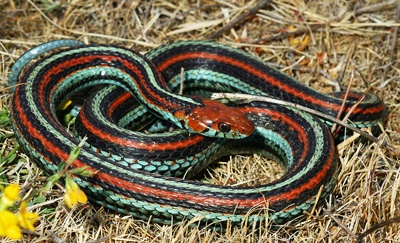We have much more to do and your continued support is needed now more than ever.
Eliminating Snakes in Your Yard
As National Wildlife Federation Naturalist, I frequently get questions from folks about “getting rid of” wildlife in their yard. Especially snakes. Unfortunately, most of the advice you can find online on the subject is bad. Mothballs are often suggested, but they are toxic. Commercial snake “repellants” are usually made of the same chemical. Most importantly though, they don’t work to repel snakes anyway, so don’t waste your money. Mowing or cutting away all of the vegetation and brush in your yard removes important habitat for birds, butterflies and other backyard wildlife.
So what’s a person to do when snakes show up in their garden? The answer is sit back and enjoy it! There’s no need to eliminate snakes in your yard.
Really the only problem is one of perception. Snakes are perceived as “bad” because of deep seated cultural traditions as well as psychological phobia. As a culture, we fear snakes and we reinforce that fear in our children. And yet, as a group snakes are some of the most harmless—and most important—wildlife that we can attract to our gardens. In fact, the vast majority of snakes are 100% harmless to people. Yet, the most common reaction most people have when they see a snake is to want to kill or eliminate it.

At National Wildlife Federation we try to help people understand that if a snake shows up in their yard, they are doing something right. It’s something to be celebrated. It means that the yard is a healthy ecosystem that is helping wildlife of all kinds to survive. And those are the exact kinds of yards that NWF certifies via our Garden for Wildlife program.
That said, we don’t encourage wildlife getting into our homes, so here are some tips to keep the snakes outside and avoid any conflicts with them:
- Critter-proof your attic and basement or crawl-space areas by making sure all access entry points have tight fitting doors or windows. Caulk any cracks or crevices that might allow snakes to enter.
- Keep screens in windows and don’t leave doors open.
- Keep brush or rock piles and dense vegetation away from the foundation of your house.
- Build brush or rock piles and plant dense vegetation on the outskirts of your property to attract snakes to those areas, away from your home.
- If you have rats or mice in your home, work to eliminate them as they can be viewed as a food source by snakes.

Garter snake in California. Photo by Gary Nafis. - Never use cruel glue traps—for rodents or for snakes.
- Encounters with venomous snakes in backyards are rare. Learn what snakes are venomous in your area so you know which snakes are actually dangerous, and which are totally harmless. Here’s a great state-by-state listing of venomous snakes in North America.
- If you do encounter a venomous snake in your yard, don’t try to move or kill it. Call a professional wildlife removal company with experience with venomous snakes, or just let it be if children and pets aren’t present.
- Here are two good listing of all the snakes in North America to help you identify any snake that shows up in your yard: Snakes of North America and Discover Life’s Snake Guide.
- Never deliberately approach any snake or try to touch or handle it, and you’ll eliminate any chance of ever being bitten. This goes for all wildlife. Teach this rule to children.
Snakes are beautiful and important wildlife. Enjoy them!
Want to make the most out of gardening, and help wildlife? Become a wildlife gardener with the National Wildlife Federation. It’s free and you’ll get great wildlife gardening tips and learn how to certify your yard as an official habitat.
Garden for Wildlife





















